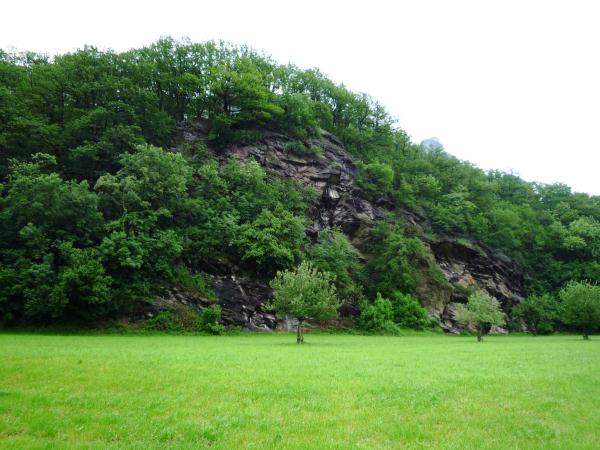Red Verrucano EarthCache
-
Difficulty:
-

-
Terrain:
-

Size:  (other)
(other)
Please note Use of geocaching.com services is subject to the terms and conditions
in our disclaimer.
[EN] In the region between the rivers Linth and Rhein in Eastern Switzerland stones and rocks of red to purple colour can be seen on many places.
These rocks are of Verrucano type.
[DE] Im Gebiet zwischen den Flüssen Linth und Rhein in der Region Sarganserland-Walensee trifft man vielerorts auf rot bis violett gefärbte Steine und Felsen.
Diese Färbung ist typisch für die Verrucano-Gesteine.

[EN] Verrucano rocks vary from fine-grained sandstone to coarse-grained conglomerate. Generally they have a characteristic red to violet colour. Green spots in the rocks are caused by chemical reduction of iron compounds.
Verrucano developed in a dry desert landscape with highly weathered mountains. The rare rains swept large amounts of dust and sand from these mountains to the lowlands. The material was deposited there as sand or gravel and hardened later on.
These sediments are particularly widespread in the area between the Rhine Valley, Seeztal and lake Walensee. During the Ice Age the Linth-glacier transported a lot of Verrucano from the Glarus region to the lowlands.
In the past these red stones were often used as building blocks. Today they are especially popular for decoration.
Log validation
At the main coordinates you are close to the stone mine on a hill called "Tiergarten" (animals' garden) which consists of Verrucano.
The following tasks need to be fulfilled to log this cache:
- Add a picture to your log showing you and/or your GPS on-site with red Verrucano stones (voluntary). (An example for such a picture is attached.)
- Send an e-mail to the owner of this cache (see GC profile) with the answers to the following questions:
1. Estimate the length of the Tiergarten hill.
2. How old are the Verrucano stones in this region?
3. What is the name of the corresponding geological system (period)?
The answers to questions 2 and 3 cannot be found on-site.
You may log immediately. However, insufficient logs risk to be deleted.
[DE] Der Verrucano variiert vom feinkörnigen Sandstein bis zum grobkörnigen Konglomerat. Fast immer weist er eine charakteristische Rotfärbung auf. Grüne Flecken im Gestein entstanden durch chemische Reduktion von Eisenverbindungen.
Der Verrucano entstand in einer trockenen Wüstenlandschaft mit stark verwitterten Gebirgen. Die seltenen Regengüsse schwemmten grosse Mengen Staub, Sand und Verwitterungsschutt aus diesen Bergen ins Tiefland. Dort wurde das Material als Sand oder Schotter abgelagert und später verfestigt.
Diese Sedimente sind im Gebiet der Glarnerdecken zwischen Vorderrheintal, Seeztal und Walensee besonders verbreitet. Durch den eiszeitlichen Linth-Gletscher wurde viel Verrucano vom Glarnerland ins Unterland verfrachtet.
Die sogenannten roten Ackersteine waren früher begehrte Bausteine. Heute werden solche roten Findlinge gerne als Ziersteine verwendet.
Logbedingungen
An den Hauptkoordinaten stehst du in der Nähe des Steinbruchs auf dem Tiergarten-Hügel in Mels, welcher aus Verrucano-Gestein besteht.
Die folgenden Aufgaben sind zu erfüllen, um diesen Cache zu loggen:
- Ergänze deinen Log mit einem Bild vor Ort, das dich und/oder dein GPS-Gerät vor rotem Verrucano zeigt (freiwillig). (Vergleiche das angehängte Beispielbild)
- Sende eine Email an den Cache-Owner (via GC-Profil) mit den Antworten auf die folgenden Fragen:
1. Schätze die Länge des Tiergarten-Hügels.
2. Wie alt sind die Verrucano-Gesteine in der Gegend um Mels?
3. Wie heisst das entsprechende System (Periode) auf der geologischen Zeitskala?
Die Antworten auf die Fragen 2 und 3 findet man nicht vor Ort.
Es darf sofort geloggt werden. Unvollständige Logs riskieren jedoch gelöscht zu werden.

04.06.10 Fragen 3 und 4 präzisiert.
13.06.19 Frage 4 entfernt, da die Hütte nicht mehr vor Ort ist.
Additional Hints
(No hints available.)